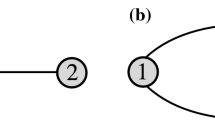Abstract
This paper applies the two-party dependence theory (Castelfranchi, Cesta and Miceli, 1992, in Y. Demazeau and E. Werner (Eds.) Decentralized AI-3, Elsevier, North Holland) to modelling multiagent and group dependence. These have theoretical potentialities for the study of emerging groups and collective structures, and more generally for understanding social and organisational complexity, and practical utility for both social-organisational and agent systems purposes. In the paper, the dependence theory is extended to describe multiagent links, with a special reference to group and collective phenomena, and is proposed as a framework for the study of emerging social structures, such as groups and collectives. In order to do so, we propose to extend the notion of dependence networks (applied to a single agent) to dependence graphs (applied to an agency). In its present version, the dependence theory is argued to provide (a) a theoretical instrument for the study of social complexity, and (b) a computational system for managing the negotiation process in competitive contexts and for monitoring complexity in organisational and other cooperative contexts.
Similar content being viewed by others
References
Bondy, J.A. and U.S.R. Murty (1977), Graph Theory and Applications. MacMillan Press Ltd, London.
AA.VV. (1993), “The Horizontal Organisation, Business Week, 20 December.
Carley, K.M. (2001a), “Intra-Organizational Computation and Complexity,” in J.A.C. Baum (Ed.) Companion to Organizations. Blackwell.
Carley, K.M. (2001b), “Smart Agents and Organizations of the Future,” in L. Lievrouw and S. Livingstone (Eds.) The Handbook of New Media. Sage, Thousand Oaks, CA.
Carley, K.M. and Y. Ren (2001), “Tradeoffs Between Performance and Adaptability for C3I Architectures,” Proceedings of the 2001 Command and Control Research and Technology Symposium. Annapolis, MA.
Carley, K.M., Y. Ren and D. Krackhardt (2000), “Measuring and Modeling Change in C3I Architectures,” Proceedings of the 2000 Command and Control Research and Technology Symposium. Naval Postgraduate School, Monterrey, CA June 26–28.
Carley, K.M. and V. Hill (2001), “Structural Change and Learning Within Organizations,” in A. Lomi (Ed.) Dynamics of Organizational Societies: Models, Theories and Methods. MIT Press, Cambridge, MA.
Carley, K.M. and D. Krackhardt (1999), “A Typology for C2 Measures,” Proceedings of the 1999 International Symposium on Command and Control Research and Technology. Newport, RI.
Castelfranchi, C., A. Cesta and M. Miceli (1992), “Dependence Relations in Multi-Agent Systems,” in Y. Demazeau and E. Werner (Eds.) Decentralized AI—3. Elsevier, North-Holland.
Conte, R. (1999), “Social Intelligence Among Autonomous Agents,” Computational and Mathematical Organization Theory, 5(3), 203–228.
Conte, R. and C. Castelfranchi (1995), Cognitive and Social Action. UCL Press, London.
Conte, R. and R. Pedone (1998), “Finding the Best Partner: The PART-NET System,” in J.S. Sichman, R. Conte and N.G. Gilbert (Eds.) Multi-Agent Systems and Social Simulation. Springer, Berlin.
Conte, R. and J.S. Sichman (1995), “DEPNET:Howto Benefit from Social Dependence,” Journal of Mathematical Sociology, 20(2/3), 161–177.
Conte, R., V. Veneziano and C. Castelfranchi (1998), “The Computer Simulation of Partneraship Formation,” Computational and Mathematical Organization Theory, 4(4), 293–315.
Cook, K.S. and R.M. Emerson (1978), “Power, Equity and Commitment in Exchange Networks,” American Sociological Review, 43, 721–739.
Crabtree, B. (1998), “What Chance Software Agents,” The Knowledge Engineering Review, 13, 131–137.
Gould, R.V. (1993), “Collective Action and Network Structure,” American Sociological Review, 58, 182–196.
Gutmann, R.H., A.G. Moukas and P. Maes (1998), “Agent—Mediated Electric Commerce: A Survey,” The Knowledge Engineering Review, 13, 147–161.
Holland, J. (1995), Hidden Order: How Adaptation Builds Complexity. Helix Books.
Ito, M. and J.S. Sichman (2000), “Dependence Based Coalitions and Contract Net: A Comparative Analysis,” Proceedings of International Joint Conference IBERAMIA/SBIA. Springer Verlag, LNAI Series, 1952, pp. 106–116.
Jennings, N. (1995), “Controlling Cooperative Problem Solving in Industrial Multi-Agent System Using Joint Intentions,” Artificial Intelligence, 75, 195–240.
Kaminka, G.A. and M. Tambe (1998), “What'sWrongWith Us? Improving Robustness through Social Diagnosis,” Proceedings of the National Conference on Artificial Intelligence (AAAI-98).
Krackhardt, D. and K.M. Carley (1998), “A PCANS Model of Structure in Organizations,” Proceedings of the 1998 International Symposium on Command and Control Research and Technology. Monterray, CA.
Maes, P. (1994), “Agents that Reduce Work and Information Overload,” Comm ACM, 37, 31–40.
Maguire, S. and B. McKelvey (1999), “Complexity and Management: Moving from Fad to Firm Foundations,” Emergence, 1, 19–61.
Marcjan, R. and E. Navarecki (1995), “Cooperation, Competition and Conflicts in Agent-Based Systems,” Proceedings of Decentralized Intelligent and Multi-Agent Systems, Krakow, Poland.
Markovsky, B.J. Skvoretz, D. Willer, M.J. Lovaglia and J. Erger (1993), “The Seeds ofWeak Power: An Extension of Network Exchange Theory,” American Sociological Review, 58, 197–209.
Marwell, G., P. Oliver and R. Prahl (1988), “Social Networks and Collective Action: A Theory of the Critical mass III,” American Journal of Sociology, 94, 502–534.
O'Brien, P.D. and M.E. Wiegand (1998), “Agent Based Process Management: Applying Intelligent Agents to Workflow,” The Knowledge Engineering Review, 13, 161–175.
Pfeffer, J. (1981), Power in Organizations. Pitman, London.
Shehory, O. and S. Kraus (1995), “Coalition Formation Among Autonomous Agents: Strategies and Complexity,” in C. Castelfranchi and J.P. Mueller (Eds.) From Reaction to Cognition. Springer, Berlin.
Sichman, J.S. (1998), “DEPINT: Dependence-Based Coalition Formation in an Open Multi-Agent Scenario,” Journal of Artificial Societies and Social Simulation, 1(2) http://www.soc.surrey.ac.uk/JASSS/1/2/3. html.
Sichman, J.S., R. Conte, C. Castelfranchi and Y. Demazeau (1994), “A Social Reasoning Mechanism Based on Dependence Networks,” in A.G. Cohn (Ed.) Proceedings of the 11th European Conference on Artificial Intelligence. John Wiley & Sons, Baffins Lane, England.
Sichman, J.S. and Y. Demazeau (2001), “On Social Reasoning in Multi-Agent Systems,” Revista Ibero-Americana de Inteligencia Artificial, 13, 68–84. AEPIA, Madrid.
Skvoretz, J. and D. Willer (1993), “Exclusion and Power:ATest of Four Theories of Power in Exchange Networks,” American Sociological Review, 58, 801–818.
Willer, D. (Ed.) (1992), “The Location of Power in Exchange Networks,” Special Issue of Social Networks, 14.
Yamagishi, T. and K.S. Cook (1993), “Generalized Exchange and Social Dilemmas,” Social Psychology Quarterly, 560, 235–249.
Author information
Authors and Affiliations
Rights and permissions
About this article
Cite this article
Conte, R., Sichman, J.S. Dependence Graphs: Dependence Within and Between Groups. Computational & Mathematical Organization Theory 8, 87–112 (2002). https://doi.org/10.1023/A:1016084432602
Issue Date:
DOI: https://doi.org/10.1023/A:1016084432602




